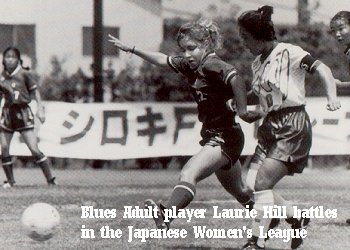 The birth of the womenÆs football teams in Japan dates back to 1967 when the formation of the team was realized at Kobe Jogakuin University, a women s college in Kobe City.
The birth of the womenÆs football teams in Japan dates back to 1967 when the formation of the team was realized at Kobe Jogakuin University, a women s college in Kobe City.
 The birth of the womenÆs football teams in Japan dates back to 1967 when the formation of the team was realized at Kobe Jogakuin University, a women s college in Kobe City.
The birth of the womenÆs football teams in Japan dates back to 1967 when the formation of the team was realized at Kobe Jogakuin University, a women s college in Kobe City.
 Through the 1970 s, the number of teams had been increasing and the regional leagues were formed in the Kanto (Tokyo and the surrounding districts) and Kansai (Osaka and Kyoto areas) areas.
Through the 1970 s, the number of teams had been increasing and the regional leagues were formed in the Kanto (Tokyo and the surrounding districts) and Kansai (Osaka and Kyoto areas) areas.
As a matter of course among the parties involved, a body of opinions emerged demanding the creation of a national organization to promote the healthy development of womenÆs football in Japan.
WomenÆs football teams in Japan were thus organized across the country by 1979 and the following year the first national tournament was held. In light of the subsequent participation of the Japanese national womenÆs team in international tournaments, the rapidly increasing number of women playing football in Japan and also the worldÆs thriving trend in womenÆs football, the Football Association of Japan (JFA) inaugurated the Women's Football League in 1989, as the premier league of Japan in women's football.
The JFA family of women's football numbers 1,161 teams with 22,219 people as of August, 1996.
In 1995, the Japanese National Women's Team reached the quarter final at the 2nd FIFA WOMEN'S WORLD CUP SWEDEN 1995, which enabled them qualify for the 1996 Atlanta Olympic Games.
The Olympic games had opened up a new and challenging aspect for women players in Japan.

The Women's Football League (WFL) was established in 1989. There were six teams in the original league, and two years later in 1991, the members increased to ten teams as seen today. Each team holds 18 games on a home-and-away basis in two independent sessions throughout a season.
 In February of 1993, promotion and relegation rules between the WFL and second best league, named the Challenge League, were introduced. By these rules, at conclusion of each season, the least successful of the WFL and the winner of the Challenge League then enter into play-off matches.
In February of 1993, promotion and relegation rules between the WFL and second best league, named the Challenge League, were introduced. By these rules, at conclusion of each season, the least successful of the WFL and the winner of the Challenge League then enter into play-off matches.
The rules of the games are in compliance with FIFA Rules. Each game is played 45 minutes each way with 15 minutes half-time, and if the game ends in a draw, a further 10 minutes each way will be played with a sudden death play off rule. Still there will be PK matches.
Each team is able to register as many as five (5) foreign players. But the number of foreign players who can be registered and play for each team is limited to three (3) per game. There are 34 foreign players registered in the League as of August, 1996, including Hege Riisa and Linda Medalen, both from the 1995 World Cup Championship.
Some players are as young as 16 years old. The major reason for this is that women's football has not yet been viewed as part of the school curriculum in Japan. Therefore, young talented players, who would assume important roles in the next generation, seek their enrollment in the WFL.
With a view to improving skills, tactics, and physical conditions of these youngsters, special training programs have been arranged. Exclusive training programs called "Sydney Plans", have also been provided to nominees under 22, for eh 2000 Sydney Olympic Games.
 BACK TO BLUES NEWS
BACK TO BLUES NEWS